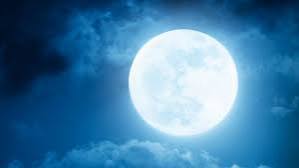For the second year in a row, Raksha Bandhan or Rakhi which is celebrated on the full moon day (that is on Purnima in the month of Shravan), will be marked by the sighting of a ‘super blue moon’ on Monday (August 19). This is an unusual astronomical feat — the full moon being both a “blue moon” and a “super moon,” giving rise to the “Super Blue Moon,” a rare trifecta of astronomical events.
According to NASA, “In many traditional Moon-based calendars the full Moons fall on or near the middle of each month. This full Moon is near the middle of the seventh month of the Chinese year of the Dragon, Safar in the Islamic calendar, and Av in the Hebrew calendar. Av corresponds with Tu B’Av, a holiday in modern Israel similar to Valentine’s Day”.
This special moon will rise at 6:57 pm in Delhi on August 19, a little later in Mumbai and about an hour earlier in Kolkata.
What is a super moon?
The orbit of the moon around the earth is not circular; it is elliptical, that is, an elongated or stretched-out circle. It takes the moon 27.3 days to orbit the earth.
Although, it takes 29.5 days between new moons. This is because while the moon is orbiting the earth, both the earth and the moon are also moving around the sun — and it takes additional time for the sun to light up the moon in the same way as it does at the beginning of every revolution around the earth. The new moon is the opposite of the full moon. It is the darkest part of the moon’s invisible phase, when its illuminated side is facing away from the earth.)
The point closest to earth in the moon’s elliptical orbit is called perigee, and the point that is farthest is called apogee. A super moon happens when the moon is passing through or is close to its perigee, and is also a full moon. (This happens with a new moon as well, just that it is not visible.)
A full moon occurs when the moon is directly opposite to the sun (as seen from the earth), and therefore, has its entire dayside lit up. The full moon appears as a brilliant circle in the sky that rises around sunset and sets around sunrise. The moon appears ‘full’ not just on Purnima, but also on the night before and after the full moon night.
And what is a blue moon?
Though the expression “once in a blue moon” implies a rare or unusual occurrence, a blue moon is not that rare an astronomical phenomenon. There are a couple of definitions of a blue moon.
One that is most commonly understood — and is endorsed by NASA — describes the situation when a full moon is seen twice in a single month. Because the new moon to new moon cycle lasts 29.5 days, a time comes when the full moon occurs at the beginning of a month, and there are days left still for another full cycle to be completed. Such a month, in which the full moon is seen on the 1st or 2nd, will have a second full moon on the 30th or 31st. According to NASA, this happens every two or three years.
Another widely accepted explanation relies on the astronomical season, defined as a period between a solstice and an equinox. The current astronomical summer began with the summer solstice on June 21, and will end with the autumn equinox on September 22. The Maine Farmers’ Almanac in 1937 defined a blue Moon as the third full Moon in a quarterly season of four full Moons.
The August super blue moon marks the first of four consecutive sightings of the super moon for this year, the next appearing on September 18, October 17 and November 15.
So will the Super Blue Moon actually appear blue?
No. Sometimes, smoke or dust in the air can scatter red wavelengths of light, as a result of which the moon may, in certain places, appear more blue than usual. But this has nothing to do with the name “blue” moon.



